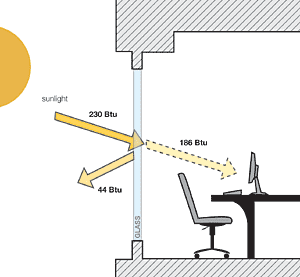Daylight in the Office Space
Solar Heat Gain
One of the largest building expenses caused by uncontrolled daylight is due to solar heat gain. The sun's radiant energy appears in the Earth's atmosphere as visible light, UV radiation, or heat, depending upon its wavelength. Solar heat gain refers to the amount of solar heat energy that passes through the windows and walls, warming the building's interior. The amount of solar heat energy that is transmitted into a space can be measured in British thermal units (Btu).
The Btu is the universal heat energy unit required to raise the temperature of one pound of water 1 degree Fahrenheit.
As window-to-wall ratios increase to allow more natural light into the structure, more and more of the building's envelope becomes glass, instead of brick, concrete and steel. The thermal transmittance of glass is much higher than that of other structural materials, making a building with a lot of glass more susceptible to solar heat gain.
|
||||||||||||||
The amount of solar energy present at any given time is dependent upon the latitude and orientation of the space and the weather conditions of the day.
(See Figure 1) This representation illustrates the thermal interaction between sunlight and a glass window in an office space located approximately in New York City. In this example, the 1/4" clear plate of glass reflects only 20 percent of the available Btu. 80 percent of the sun's heat energy radiates into the interior.
As more of the sun's light and heat energy is allowed into a space, the interior is warmed and a greater demand is placed upon the HVAC system to keep building occupants comfortable.
Specifying a device to be an additional barrier between the window glass and the building's interior space creates an opportunity for some of the solar energy to be reflected back outside or absorbed by the apparatus, before seeping into the occupied spaces. Both color and composition of this barrier device are important considerations when determining which technology to select.
Even with the potential threats of glare and solar heat gain, the potential benefits of including daylight in the workplace to both employees and building performance are considered significant enough to continue exposing office spaces to the outdoors. This demand for daylight in the workplace has driven the development of numerous technologies designed to manage the impact that natural light can have on a space. It has also been a catalyst for the popularity of the daylighting movement.










